| |
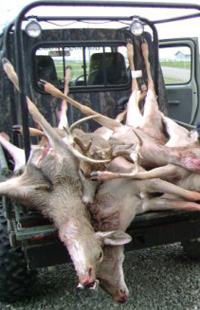 |
Why would we, as a community, consider paying others to perform deeds under the cover of darkness that most of us would be unwilling to witness, much less carry out ourselves in the full light of day?
|
|
Virtually all programs involving government-sponsored killing of suburban deer do not allow concerned citizens or members of the media to observe, much less document, the killing process or its aftermath. Consequently, the times, dates, and locations of the killing are not made public. Officials usually explain this as being necessary for safety reasons.
But Tim Setnicka, former Superintendent of the Channel Islands National Park, reveals a different motive. During his 30-year career with the Park Service, Setnicka supervised numerous large-scale wildlife killing programs. In 2005, he began to speak out against what he came to consider park superintendents "playing god."
"We never allowed the media to accompany the hunters to film the hunting activity. Safety reasons were always given as reasons for denial of their request. The real reason is that we wanted to avoid images of the ugliness of the hunt," admits Setnicka. "You watch the life drain out of their eye, which becomes dull as they die. This is an impossible image to sell the public or politicians, which is why no photos are allowed." 1
The Cover of Darkness
If a program is approved for government-sponsored killing of deer in our community, the killing will most likely be carried out by armed, out-of-town contractors, under the cover of darkness, the sound of gunshots muffled by silencers, the bodies of the dead animals carted away by municipal workers before sunrise.
Were such acts to be carried out in the light of day and memorialized in the media, most of us would be appalled by what was revealed. We certainly would not want our children to watch how unsuspecting human-habituated animals were lured with bait, and then methodically slaughtered. Most of us would be tempted to avert our eyes from the abruptness of the bullets' impact, the blood and gore, the agonizing struggle of the maimed and dying, the orphaned young, the killing of pregnant females and their unborn offspring, and yes, the life draining out of their eyes.
What, or Who?
Both the science of cognitive ethology and common sense observation indicate that individual deer, like other mammals, care about what happens to themselves and their family members. They avoid suffering and vigorously seek to escape violence and death just as we do. And as many of us have observed with our own eyes, deer exhibit many behaviors that express emotions we can easily recognize—caution, fear, curiosity, joy, protectiveness of their young.
|
|
|
Meet some of the individual deer from our community who are in danger of being killed by Cayuga
Heights' proposed bait and shoot program. (mouseover each thumbnail to take a closer look) |
Even the proponents of killing our suburban deer frequently comment on the cleverness individual deer show when evading capture or death, and how they learn to circumvent some of the protective measures taken by gardeners. Yet these same people do not seem to realize that each time they acknowledge the individuality and mental capacity of the deer, they are undermining the very foundations of their own position that killing these individuals is morally justifiable.
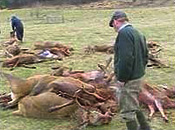 |
Few people grasp the reality of what it means to systematically kill these peaceful animals.?
|
|
Misleading Language
Those who lobby for the slaughter of suburban deer favor the use of the word "culling." But what does this word really mean? According to the dictionary, culling means to choose; select; pick; to gather the choice things or parts from; to collect; gather; pluck. In our community, the proponents of a killing program are also using a new word, "remediation," which the dictionary defines as the act of correcting an error or a fault or an evil.
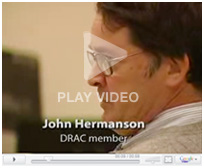 |
DRAC members advocate for killing deer, calling them a "weed species." 
|
|
While there is no doubt that some people experience conflict with suburban deer, is it in any way accurate, or even rational, to refer to living creatures as "an error or a fault or an evil" that will be "corrected" through killing?
Were the English language to be used this same way to describe the killing of humans, or even dogs and cats, most of us would find it disturbing and unacceptable. Yet through constant repetition, this sort of language, and the tragic disconnect behind it, becomes normal. It passes by largely unquestioned as we apply it to the deer who are indigenous to our region and have ended up living in our backyards largely due to the man-made problem of suburban sprawl. One proponent of a killing program has even gone so far as to publicly rationalize the killing by calling the deer "a weed species." 2
|
|
| These photos of the aftermath of a bait and shoot program are hard to look at, but
they don't even begin to communicate the violence that is taking place in Rochester Hills, Michigan, where they are now killing suburban deer. (click an image to enlarge it) |
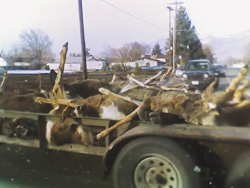
|
Once any group, human or nonhuman, is labeled as a "pest" or "weed" or unwanted interloper, those in the marginalized group fall outside of our circle of moral consideration. |
|
First Labeling, Then Violence
Once any group, human or nonhuman, is labeled this way, as a "pest" or "weed" or unwanted interloper, those in the marginalized group fall outside of our circle of moral consideration. We eventually come to speak of these individuals collectively as objects, even as a "resource" that is to be "managed."
But does this kind of euphemistic language, and the psychological disconnect behind it, represent our community's best aspirations for itself? How can we justify paying others to perform deeds under the cover of darkness that most of us would be unwilling to witness, much less carry out ourselves in the full light of day? Is this who we are as a community
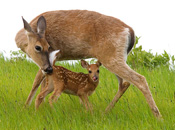 |
What will we teach our children about how to resolve conflict? Will it be violence, or creative problem solving?
|
|
The Choice is In Our Hands
The deer have no voice, and no choice, in this matter. It is up to us to decide what happens.
Thankfully, we have the ability as a community to chose to set aside violent options, to work together to find an approach to decreasing the impact of deer-human conflict that is safe, ethical, and rational. In doing so, we will not only be following our own best traditions, we will
also be blazing a trail that can be followed by the many communities nationwide who are struggling with similar issues.
This web site is published by CayugaDeer.org - Ithacans for Safe, Ethical, and Rational Approaches to Reducing Deer-Human Conflict. We are a group of concerned citizens from Ithaca neighborhoods, including Cayuga Heights. If you would like to join our educational outreach effort and be informed of opportunities where your input can make a difference, contact us.
References:
|
